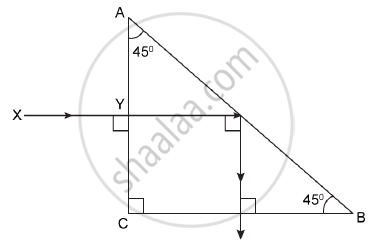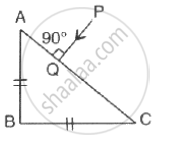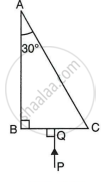Advertisements
Advertisements
Question
Mention one difference between reflection of light from a plane mirror and total internal reflection of light from a prism.
Solution
| Reflection of light from a plane mirror | Total internal reflection of light from a prism |
|
A prism that experiences total internal reflection returns 100% of the incident light back into the denser medium. |
Ordinary reflection from a plane mirror is partial because some light is absorbed or refracted. |
APPEARS IN
RELATED QUESTIONS
A ray of light XY passes through a right-angled isosceles prism as shown below

- What is the angle through which the incident ray deviates and emerges out of the prism?
- Name the instrument where this action of the prism is put into use.
- Which prism surface will behave as a mirror?
What is a total reflecting prism?
In the following figure, a ray of light PQ is incident normally on the hypotenuse of an isosceles right angle prism ABC.
- Complete the path of the ray PQ till it emerges from the prism. Mark in the diagram the angle wherever necessary.
- What is the angle of deviation of the ray PQ?
- Name a device in which this action is used.

What device other than a plane mirror can be used to turn a ray of light through 180°? Draw a diagram in support of your answer. Name an instrument in which this device is used.
Draw a neat labelled ray diagram to show the total internal reflection of a ray of light normally incident on one face of a 30°, 90°, 60° prism.
A total reflecting equilateral prism can be used to deviate a ray of light through ______.
A total reflecting right angled isosceles prism can be used to deviate a ray of light through ______.
State three actions that a total reflecting prism can produce.
Complete the path of ray PQ through the glass prism ABC shown in Fig. till it emerges out of the prism. Given the critical angle of the glass is 42°.

Draw a diagram to show one such action of the total reflecting prism.
